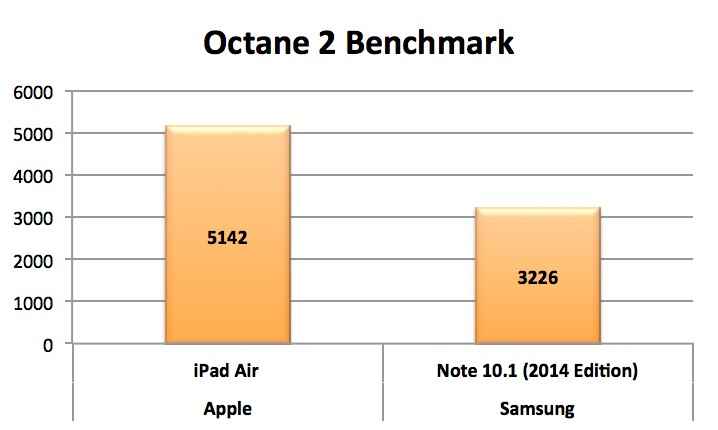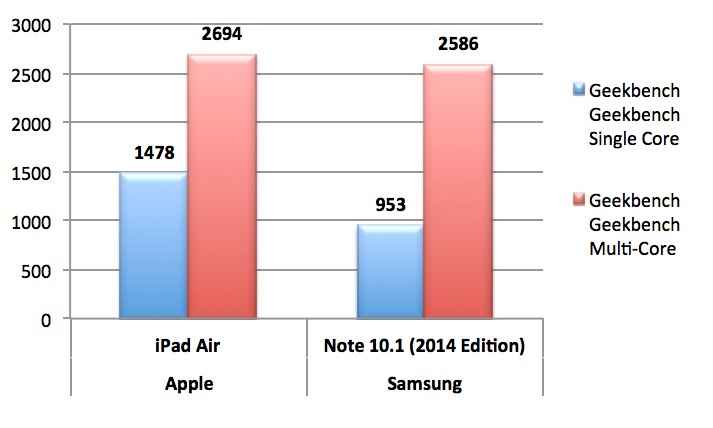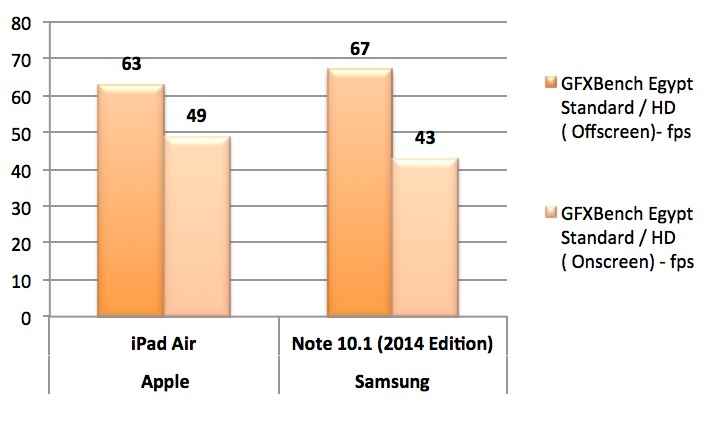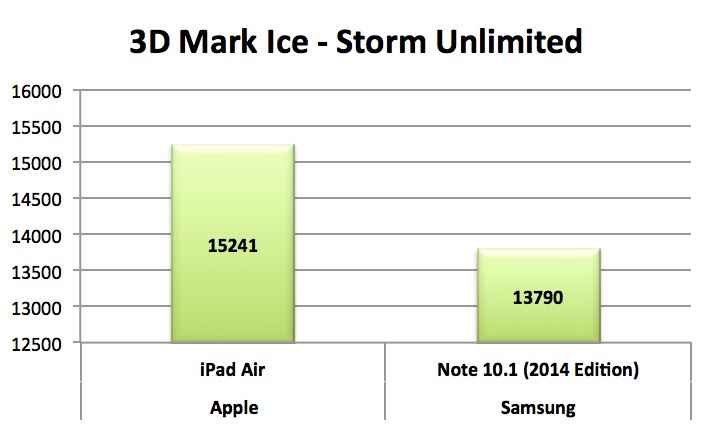.jpg)
PROS CONS
Brilliant high-res display Battery life still not close to the iPad
Good performance Plastic frame doesn't feel high quality
Leather-like back panel helps with grip Expensive
Expandable memory
Complete range of S-Pen features
Decent camera
Brilliant high-res display Battery life still not close to the iPad
Good performance Plastic frame doesn't feel high quality
Leather-like back panel helps with grip Expensive
Expandable memory
Complete range of S-Pen features
Decent camera
"The Samsung Galaxy Note 10.1 2014 is the weapon of tablets, offering a slightly compromised tool for almost every job you could imagine."
| General | |
|---|---|
| Release date | February 2014 |
| Dimensions (mm) | 171.00 x 243.00 x 7.90 |
| Weight (g) | 547.00 |
| Battery capacity (mAh) | 8220 |
| Removable battery | No |
| SAR value | NA |
| Display | |
| Screen size (inches) | 10.10 |
| Resolution | 2560x1600 pixels |
| Pixels per inch (PPI) | 299 |
| Colours | 16M |
| Hardware | |
| Processor | 1.9GHz |
| RAM | 3GB |
| Internal storage | 16GB |
| Expandable storage type | SD card |
| Camera | |
| Rear camera | 8-megapixel |
| Flash | No |
| Front camera | 2-megapixel |
| Software | |
| Operating System | Android 4.3 |
| Java support | Yes |
| Browser supports Flash | No |
| Connectivity | |
| Wi-Fi | Yes |
| Wi-Fi standards supported | NA |
| GPS | Yes |
| Bluetooth | Yes |
| NFC | No |
| Infrared | No |
| DLNA | Yes |
| Wi-Fi Direct | Yes |
| MHL Out | No |
| HDMI | No |
| Headphones | 3.5mm |
| FM | No |
| USB | Micro-USB |
| Charging via Micro-USB | Yes |
| Proprietary charging connector | No |
| Proprietary data connector | No |
| Number of SIMs | 1 |
| SIM Type | Micro-SIM |
| GSM/ CDMA | GSM |
| 3G | Yes |
| Voice Calling | Yes |
| Stylus | Yes |
| Sensors | |
| Compass/ Magnetometer | Yes |
| Proximity sensor | Yes |
| Accelerometer | Yes |
| Ambient light sensor | Yes |
| Gyroscope | No |
| Barometer | No |
| Temperature sensor | No |
Build & Design
However, it is quite disappointing that the build quality still is a couple of notches below perfect. Press hard on the middle of the back panel, and it does bend a bit. The plastic on the spines just looks bolted on as an afterthought. And the port covers over the SIM and microSD card slots feel flimsy at best. Up front and at the back, the design elements seem extremely different, more like a case of two halves, as they say in football. You have the fake leather look at the back, and the more conventional Samsung-ish design up front, complete with the hardware key for home, and touch keys for menu and return - exactly the same as most Galaxy smartphones.
The Note 10.1 (2014 Edition) has much more compact dimensions than the version it succeeds - 243.1mm x 171.4mm x 7.9mm and weighs 535 grams. While the weight reduction is massive, generation-wise, it still is heavier and bigger than the Apple iPad Air (240mm x 169.5mm x 7.5 mm; 478 grams). Albeit, do note (no pun intended) that there is a slight difference in the screen size of both tablets, and that does have a bearing on the Samsung’s apparent disadvantage on the spec sheet.
One thing that does catch your attention is that there is no notification LED that will indicate charging status or any new update from an app. If you hold the tablet in landscape mode, there is a speaker grill on the left and right side spines. The top spine has the power key and the volume rocket, while the bottom spine has the micro USB port for charging and data transfer.
.jpg)
Display
The display is one area where Samsung has never lagged behind Apple. The Note 10.1 builds on that brilliance, with the 10.1-inch Super Clear LCD panel, with a massive resolution bump up to 2,560 x 1,600 pixels. You really will find it very difficult to find a 10-inch tablet with such a brilliant display, in terms of native brightness, crispness of text rendered and the colour richness without any particular shades popping unnaturally, one problem we always noticed on AMOLED displays. The display goes well beyond Full HD resolutions, and that makes this tablet very much future proof.
In terms of brightness levels, the Note 10.1 registers a Luxmeter reading of 1654, while the iPad Air’s 9.7-inch screen registered 1522, both at 100% brightness with the same content on the screen. And it is that base that the Note 10.1 builds on. Between these two displays, the whites look purer on the Note 10.1, and so does the text for the same content. Where the iPad has the advantage is with the slightly softer colours and the warmer tones, if one prefers that.
Be it Real Racing 3, or the 1080p version of Elysium, the sheer richness of the display is something you just cannot ignore. Switch over to reading, and for that, I specifically use the Kindle Reader app and also Flipboard. The text rendering is absolutely fantastic, with just the perfect amount of crispness. Incidentally, there seems to be some issue with the default browser - try zooming into text on a web page, and it looks fuzzy for a second, before returning to perfection.
.jpg)
Audio
One issue that the iPad Air improved on, over the previous generation, was the introduction of dual speakers, instead of just one on the 4th generation iPad. Samsung had packed in the two side spine mounted speakers in the previous Note 10.1 as well, but this time around, the sound seems a lot better, mostly in terms of clarity at high volumes, particularly for dialogues. Though this may still not replace your headphones or any external speakers that you may use with the tablet, it's good enough for when on the move.
The Adapt Sound feature, also seen in the Galaxy S4, adjusts the audio tone and the left-right audio balance to improve the experience. To set this, you need to plug in a pair of headphones, and commence tweaking. Hit start after opening the app, and you will basically go through a multi-step hearing test with a series of high and low pitched beeps to understand the capabilities of your headphones, and also your ears in some ways.
Additionally, the built in music player has a very detailed set of equalizer settings, which makes a massive amount of difference. The cube based equalization method, in addition to the conventional equalizer is a neat feature.
Performance
The Note 10.1 packs in Samsung’s Exynos 5420 chipset with a quad core cluster at 1.9GHz and another quad core cluster at 1.3GHz, paired with 3GB of RAM. As expected, the benchmark scores make this one of the fastest Android tablets out there. But, the real comparison is with the Apple iPad Air, which itself got a processor and graphics boost not long back. But, despite all the power under the hood, the Note 10.1 is still behind the iPad Air, at least as far as the simple numbers are concerned. Within the Android ecosystem, the Note 10.1 stands alongside the 7-inch XOLO Play Tegra Note in terms of best in-class performance.


However, the fact that the test scores are still behind iOS, despite such powerful hardware, just points to the fact that Android as an OS, and the apps around it, are still not polished enough to utilize such powerful hardware to the fullest. I mean, it isn’t an issue because performance doesn’t get impacted negatively, but this does leave a semblance of a sour taste in the mouth - based on the amount of money you spend and the expectations from it.
In everyday use, the Note 10.1’s performance superiority shows. Apps open quickly, multi-tasking is a breeze, and there is no disagreeable stutter when switching between apps. This tablet is equally comfortable with almost any usage scenario you may throw at it - simple web browsing and social networking or productivity tasks or be it a session of Real Racing 3. The performance potential is well translated every time. However, this isn’t to say that the Note 10.1 is faultless. Yes, the TouchWiz UI has been further tweaked and feels much lighter than the earlier version, but you will see an occasional lag or stutter when flicking between the home screens or the app drawer pages.


It's good to note that the device doesn’t heat up when stressed, and the fake leather layer at the back is one of the reasons why your fingers aren't singed after an hour of driving very quickly around some corners in the latest iterations of Real Racing or GT Racing.
Battery
Samsung has packed in a humongous 8220mAh battery in the Note 10.1, which should mean the tablet is on fairly stable ground. However, there are other factors that come into play. First is the fact that Android isn’t as resource nimble as iOS. Second, battery life will depend on how many of Samsung’s features (for example Smart Stay) you have turned on.
In the video battery drain test, with the same HD video via VLC with screen brightness at 100% and volume at 50%, the Note 10.1's battery dropped to 86% in an hour. In the same test, the Apple iPad Air still retained 95% charge after one hour of playing the HD video.
Having said that, it is very much possible to get 8-9 hours of usage from a single charge, with assorted usage scenarios. The critical bit is to turn off all the features that you don’t need - like Smart Stay and Multi-Window.
S-Pen
Personally, I do not envisage myself using the stylus on a regular basis, forget using it on a daily basis. But, that doesn’t mean the feature isn’t important. After all, millions of Galaxy Note devices have been sold globally! The entire Air Command ecosystem of apps is just brilliant, for someone who will be using the stylus. Remove the S-Pen from its bay, and the Air Command window pops up automatically. Or you can press the button on the pen with the tip hovering just above the screen. This circular command centre opens up a lot of options - Action Memo, Scrapbook, Screen Write and Pen Window.
Action Memo lets you quickly scribble down updates or quick reminders, which get saved within the app. This can be very useful when jotting down something quickly, like a phone number. Yes, there are a lot more features within Air Command, but quite honestly, don’t think anyone will be too bothered to remember them. I most certainly hope that, like other things, this simple stylus feature that allows you to scribble notes quickly and efficiently doesn’t get bogged down by the inevitable deluge of additional features that one may or may not use.
.jpg)
No comments:
Post a Comment